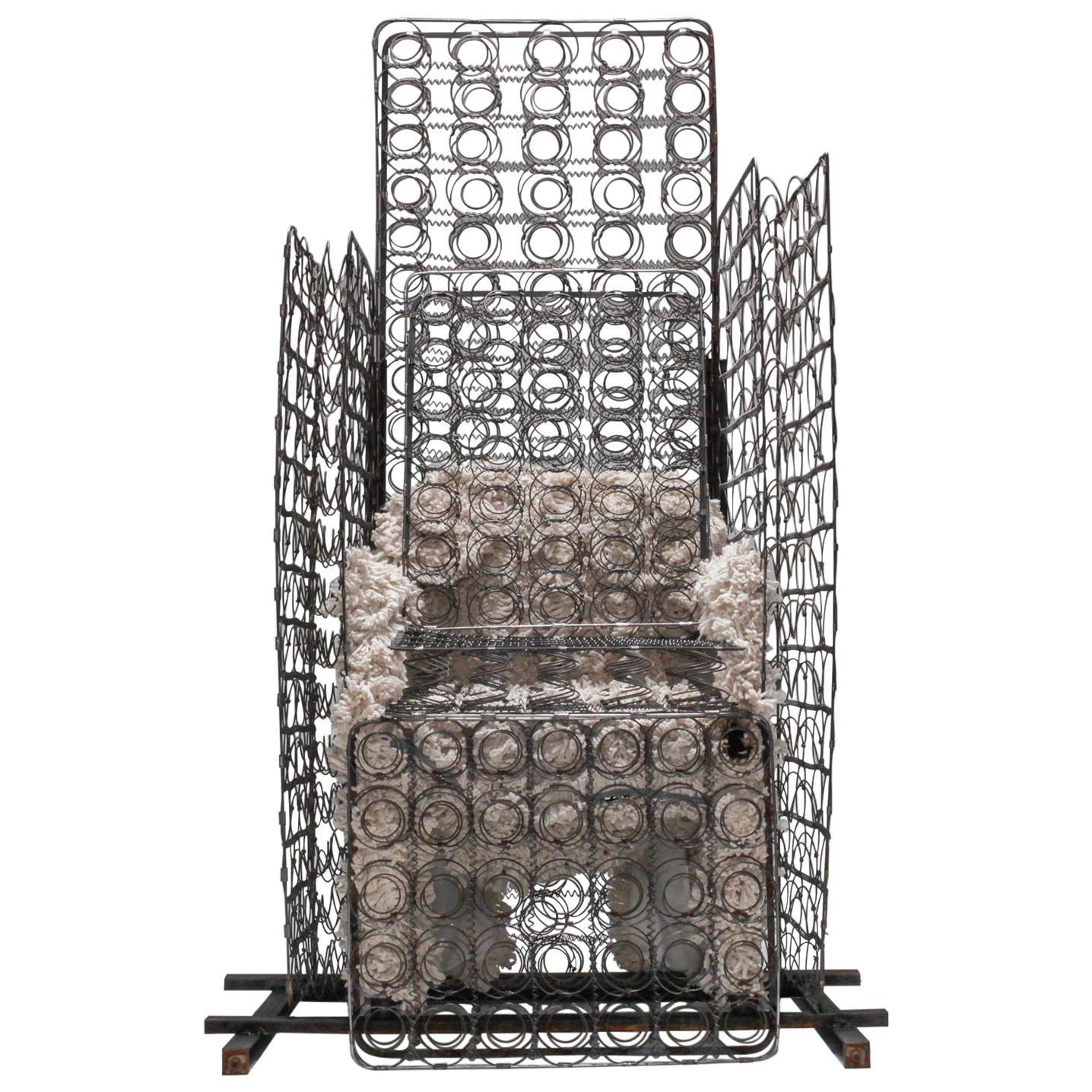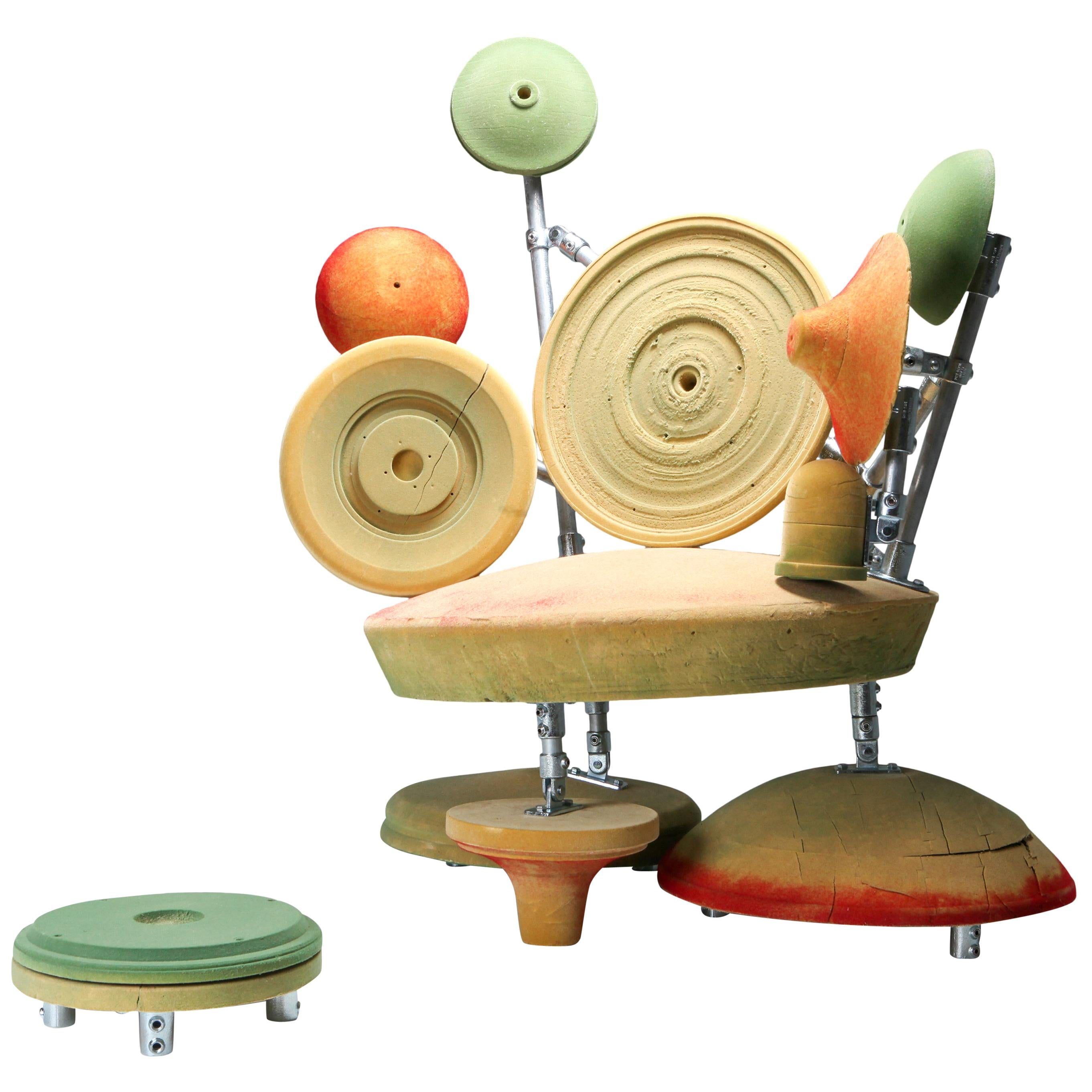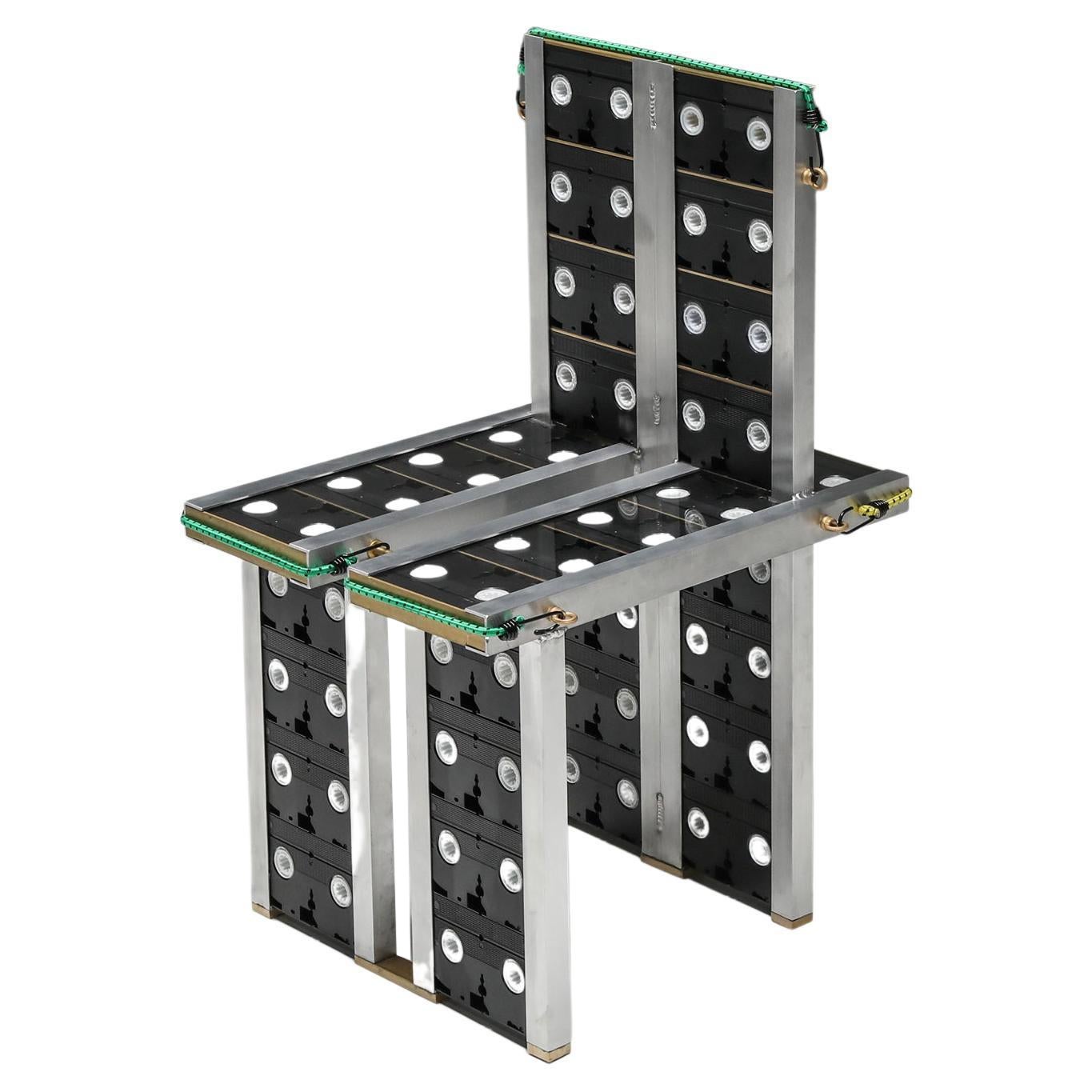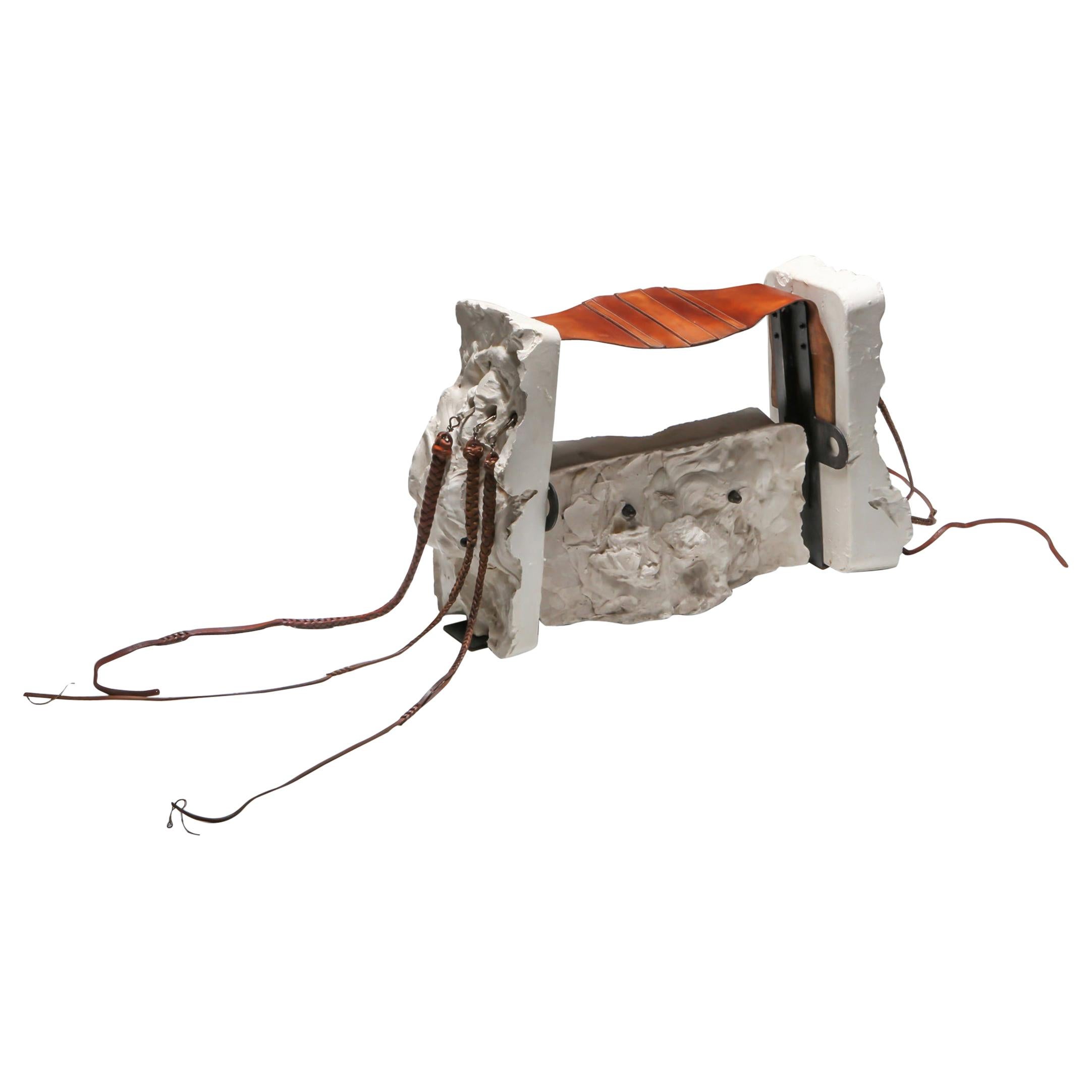Items Similar to Lionel Jadot, Jam Seat Brass, BE
Want more images or videos?
Request additional images or videos from the seller
1 of 8
Lionel Jadot, Jam Seat Brass, BE
About the Item
Lionel Jadot’s Jam Seat, is adapted from a design prototype created sometime between 1905-1910 by Jadot’s great-grandfather, the head of the legendary Vanhamme family of furniture makers. Inspired by the more geometric forms of the late Vienna Secession movement, the forward thinking chair design dismisses traditionalist style in favor of a modern, streamline look, rendered in a single material. The design is distilled into four flat planes of cut brass sheet that are pieced together like an angular puzzle. The reductive and planar form of Jam Seat predates similar conceptual designs such as Dutch designer Gerrit Rietveld’s Red and Blue Chair, created in 1917 and Shiro Kuramata’s Glass chair from 1976.
While not easily categorized by a singular style, Jadot’s work could most easily be recognized by his affinity for repurposed materials and his deft eye at creating harmony and balance out of the collision of disparate elements. With the vision and confidence to experiment and evolve, Jadot has made a practice of skirting tradition by mixing genres, inspirations, and materials to achieve his iconoclastic vision. Key to his work process is a strong belief in craftsmanship and integrity in terms of behavior and approach.
The principle of reclamation has been relevant to Jadot from a young age. As a child in his father’s workshop, Jadot developed a keen attraction and respect for materials, coveting the bits of scrap wood and leather that would accumulate around the floor and had been deemed “fair game.” Today this manifests as both a philosophical and aesthetic tenet to his work. Manipulating materials that have been salvaged permeates the works with a sense of character, history, and humanity.
Working from a near photographic mental library of materials and influences, he is at once artist, tinkerer, and inventor. He explains, “What interests me is ideas passing though memory, and the influences mixing. Culture meeting subculture, mixing genre, from memory. I filled notebooks of ideas and with this approach I decided to achieve all that was in my notebooks. It is an exciting job; it’s more an expression, free of any constraints. But it is also a free reflection on design and art, and this fragile border that I love to cross in both directions.”
- Creator:Brecht Wright Gander (Artist)
- Dimensions:Height: 33 in (83.82 cm)Width: 16 in (40.64 cm)Depth: 14 in (35.56 cm)
- Materials and Techniques:
- Place of Origin:
- Period:
- Date of Manufacture:2019
- Production Type:New & Custom(One of a Kind)
- Estimated Production Time:Available Now
- Condition:
- Seller Location:New York, NY
- Reference Number:1stDibs: LU905317052311
About the Seller
No Reviews Yet
Recognized Seller
These prestigious sellers are industry leaders and represent the highest echelon for item quality and design.
1stDibs seller since 2010
18 sales on 1stDibs
Typical response time: 5 hours
- ShippingRetrieving quote...Ships From: New York, NY
- Return PolicyThis item cannot be returned.
More From This SellerView All
- Lionel Jadot, Crushed Seat, BEBy Lionel JadotLocated in New York, NYCrushed seat, Jadot’s juxtaposed material assemblage, is a colossal manifestation of his unusual creative process. Constructed of reclaimed MDF that has been painted in vibrant color...Category
2010s Belgian Loveseats
MaterialsFoam, Reclaimed Wood, Paint
- Lionel Jadot, Fractal Dragon, BEBy Lionel JadotLocated in New York, NYFractal Dragon, Jadot’s expansive graphic cabinet, reawakens an early 20th century Japanese ink drawing depicting a floating dragon. In traditional Jap...Category
2010s Belgian Cabinets
MaterialsWalnut
- Lionel Jadot, Show Clothes, BEBy Lionel JadotLocated in New York, NYLionel Jadot’s mixed media and glass wardrobe, titled Show Clothe was conceived for a dressing room, the interior becoming an installation for its inner...Category
2010s Belgian Cabinets
MaterialsBrass, Copper, Stainless Steel
- Lionel Jadot, Leather Time, BEBy Lionel JadotLocated in New York, NYThe idea for Leather Time was a challenge to form a table in a single sheet of brass. The bright pink color was inspired by Malabar chewing gum giving its slight Industrial feel a se...Category
2010s Belgian Coffee and Cocktail Tables
MaterialsLeather
- Lionel Jadot, Prisma Flight Table, BEBy Lionel JadotLocated in New York, NYWhile not easily categorized by a singular style, Jadot’s work could most easily be recognized by his affinity for repurposed materials and his deft eye at creating harmony and balan...Category
2010s Belgian Dining Room Tables
MaterialsBrass
- Lionel Jadot and Zaventem Ateliers, Spin Love, BEBy Lionel JadotLocated in New York, NYBringing together 15 of Europe’s most exceptional artisans working across the design spectrum, Jadot has spearheaded the creation of an extraordinary mixed-media, multi-functional object in the form of an unique ping pong table, titled “Spin Love.” In addition to its recreational use, "Spin Love" can be divided with each table top elevated to serve as a double-sided room divider or screen, with a matching pair of standing floor lamps. One of the most ambitious works of decorative arts today, “Spin Love” connects the talents of the idiosyncratic, visionary artists that make up Zaventem Ateliers. Jadot is the mastermind behind Zaventem, an experimental artist workspace accommodating 32 separate workshops dedicated to the production and transformation of materials, allowing a group of exceptional craftsmen working in ceramics, leather, metal, marble, textiles, and wood to collaborate, experiment, and inspire one another. As a physical representation of the ingenuity and creative drive housed within the walls of Zaventem Ateliers, “Spin Love” asserts their commitment to old world craftsmanship, free thinking, and modern innovation. In conceiving “Spin Love” Jadot aimed to create a work where visionary design and idiosyncratic craftsmanship meets the already collaborative energy, humor and playfulness he had amassed within Zaventem. Each individual element, from the mixed media table tops to the unique ping pong paddles, showcases the height of the artists’ specific expertise. The double sided clover-shaped table top can be divided into two separate tables, each with the ability to be raised to stand upright, acting as a dual-faced screen allowing for four distinct visual options.One bifurcated table half features black and white geometrically patterned leather collages from Niyona, a French custom leather design company. Its corresponding half is composed of precious wood marquetry work by Alexandre Lowie with a steel star detail jewelry designer by Luna Lotta. The second table is composed of an integration of metalwork by Maison Jonckers and textiles from Studio Krjst enclosed within poured resin. On one side each artist’s work is tessellated into a tightly controlled pattern. Flipping the table over reveals an expressive and chaotic assemblage of patterns and textures. The freestanding, movable lamps...Category
2010s Belgian Modern Dining Room Tables
MaterialsMarble, Metal
You May Also Like
- Billie Jean Sofa by Lionel Jadot, 2020By Lionel JadotLocated in Antwerp, BEBillie Jean seat by Belgian artist Lionel Jadot, renowned for his unique assemblage of various historical elements into captivating and unique designs. This seat is made with 1960s...Category
2010s Belgian Post-Modern Benches
MaterialsCopper
- Functional Art Chair / Throne "'Spring Swab" by Lionel JadotBy Lionel JadotLocated in Antwerp, BECollectible design / Functional art, Lionel Jadot for Everyday Gallery, Belgium 2020 Born in Brussels in 1969, Lionel Jadot is an interior designer, artist, designer, filmmaker, adventurer. But all at once, preferably. Lionel Jadot is firing on all cylinders. ‘I never throw anything, I pick up everything. Not having a green thumb, I’m trying cuttings, weddings against nature. I never forget a line.’ He’s inviting us in subtle, off-beat worlds, on the edge of reality. Its material is made of dilated time. A wandering spirit, he seeks a protective balance in a hostile world. It is his constant questioning: what happens to the place where we live? For Lionel Jadot, everything is object, everything is history. He draws from other places, other times, and seeks what’s linking them. He sews, stitches, unpicks, blends materials, combines eras. He will enshrine some wood essence in metal, some mineral in a plant, the old in the new. ‘I take extra care to the joint between two materials.’ With him, there is always some play in the parts, as in a piece of machinery. From a kingdom to another, he provokes organic, viral growths, generating energy. Linking past and future, he never forgets a line. ‘I accumulate them.’ He’s inviting us in subtle worlds, off-beat, on the edge of reality. Are we in 1930 or in 2030? Both, no doubt. Its material is made of dilated time. The eye goes hand in hand with the ear. ‘When I walk into a place, I listen to the good (or bad) it does to me. An ineffable feeling.’ He recreates mutant buildings, like the future Royal Botanique, a 5 stars hotel housed in the Church of the Gesu, a former convent behind a 1940 façade. He talks about a ‘hotel object’, which he holds and turns around in his hand. A wandering spirit, he’s flirting with retro-futurism. The Jam, another hotel, is intended for urban travelers, fans of swiftness, fluidity and hospitality. He designs interiors as a set of objects: a motorcycle cut in concrete becomes a bar counter. He finds gothic cartoon echoes, from the likes of Moebius, Alejandro Jodorowsky, Enki Bilal, sets from Garage Hermétique and Blade Runner, a protective balance in a hostile world. Discovering Jadot’s little cosmos of collected and accumulated goods, it becomes clear that every element has its own story. I tried to collect them and in turn, devour them in the coming paragraphs. But first: the show is best experienced seated, barring the distinction between object of use and object of attention, they invite for different types of conversation. The seats, chairs, thrones all make us think of our own physical comportment, and of how the seat lends grandeur to the person sitting on it, by crowning its presence. The crackling floor, the felt walls and the diffuse light slow you down into an oddly absorbing environment, in which you are left puzzled. In the eclectic collages of objects, bits and pieces collected all over the world come together in ways practical, and logical, though possibly only in the artist’s mind. All his finds eventually seem to fall into place. Starting with the mere conception of a chair, rather than with a set-out plan or sketch, the works are intuitively construed out of an archive that one can only imagine the dimensions of. Things forgotten by others, precious for him, were all once designed for their own purpose. Here they find their fit as a base, a closing system or a balancing element. The first piece that opens the exhibition, the most throne-like of all seats in the show, builds around a chair of his grandmother, protected by mops, and harassed with bed springs. As you enter the space, you pass by a shell leaning over a yellow seat that stems from his old Mustang, and find a white stool piece with Mexican leather dog training whips— the white building blocks of which turn out to be dried molding material, as found and broken out of a bucket by workers every morning. Further, the stone piece that reminds one of the stone age, is indeed made of 400 million old rocks, and the soft seats are lent from construction, where these strokes of textile carry up the heaviest goods. In the corner — but as you walk this walk please be seated on any of the thrones and experience the work for a moment— the green fluffy cover is made by XXXX who remakes cartographies of warzones, one of which is here mounted on a flexible fishing chair. On an experience level, the conversation chair enhances self-confidence, while putting you literally in a good spot with the person you’re conversing with. The lamp perfectly shows the playful Cadavre Exquis...Category
2010s Belgian International Style Armchairs
MaterialsMetal
- 'T-Shink' Sprayed Textile Throne Chair, Lionel Jadot, Belgium, 2020By Lionel JadotLocated in Antwerp, BEThe 'T-Shink' functional art throne chair is constructed of elements from wooden moulds which date back to the 1950s and originally used to make stainless steel sinks...Category
2010s Belgian Post-Modern Chairs
MaterialsOther
- Functional Art 'SLV Chair' by Lionel Jadot, Belgium, 2021By Lionel JadotLocated in Antwerp, BEDesign Miami; Art Design; Art Basel; Atelier Lionel Jadot; Everyday Gallery; Contemporary; Belgian Design; Belgian Art; Chair; Functional Sculpture; Artwork; Collectible Design; Ever...Category
2010s Belgian Organic Modern Chairs
MaterialsAluminum
- Functional Art Chair / Stool "Plaster Whip" by Lionel JadotBy Lionel JadotLocated in Antwerp, BE"Plaster Whip" sculpture by Lionel Jadot A stool made of leftover plaster vats from a molding company, scrap metal, leather whips from the 1950s and a bodybuilder’s belt from the 1930s Collectible Design / Functional art , Lionel Jadot for Everyday Gallery, Belgium 2020 Born in Brussels in 1969, Lionel Jadot is an interior designer, artist, designer, filmmaker, adventurer. But all at once, preferably. Lionel Jadot is firing on all cylinders. ‘I never throw anything, I pick up everything. Not having a green thumb, I’m trying cuttings, weddings against nature. I never forget a line.’ He’s inviting us in subtle, off-beat worlds, on the edge of reality. Its material is made of dilated time. A wandering spirit, he seeks a protective balance in a hostile world. It is his constant questioning: what happens to the place where we live? For Lionel Jadot, everything is object, everything is history. He draws from other places, other times, and seeks what’s linking them. He sews, stitches, unpicks, blends materials, combines eras. He will enshrine some wood essence in metal, some mineral in a plant, the old in the new. ‘I take extra care to the joint between two materials.’ With him, there is always some play in the parts, as in a piece of machinery. From a kingdom to another, he provokes organic, viral growths, generating energy. Linking past and future, he never forgets a line. ‘I accumulate them.’ He’s inviting us in subtle worlds, off-beat, on the edge of reality. Are we in 1930 or in 2030? Both, no doubt. Its material is made of dilated time. The eye goes hand in hand with the ear. ‘When I walk into a place, I listen to the good (or bad) it does to me. An ineffable feeling.’ He recreates mutant buildings, like the future Royal Botanique, a 5 stars hotel housed in the Church of the Gesu, a former convent behind a 1940 façade. He talks about a ‘hotel object’, which he holds and turns around in his hand. A wandering spirit, he’s flirting with retro-futurism. The Jam, another hotel, is intended for urban travelers, fans of swiftness, fluidity and hospitality. He designs interiors as a set of objects: a motorcycle cut in concrete becomes a bar counter. He finds gothic cartoon echoes, from the likes of Moebius, Alejandro Jodorowsky, Enki Bilal, sets from Garage Hermétique and Blade Runner, a protective balance in a hostile world. Discovering Jadot’s little cosmos of collected and accumulated goods, it becomes clear that every element has its own story. I tried to collect them and in turn, devour them in the coming paragraphs. But first: the show is best experienced seated, barring the distinction between object of use and object of attention, they invite for different types of conversation. The seats, chairs, thrones all make us think of our own physical comportment, and of how the seat lends grandeur to the person sitting on it, by crowning its presence. The crackling floor, the felt walls and the diffuse light slow you down into an oddly absorbing environment, in which you are left puzzled. In the eclectic collages of objects, bits and pieces collected all over the world come together in ways practical, and logical, though possibly only in the artist’s mind. All his finds eventually seem to fall into place. Starting with the mere conception of a chair, rather than with a set-out plan or sketch, the works are intuitively construed out of an archive that one can only imagine the dimensions of. Things forgotten by others, precious for him, were all once designed for their own purpose. Here they find their fit as a base, a closing system or a balancing element. The first piece that opens the exhibition, the most throne-like of all seats in the show, builds around a chair of his grandmother, protected by mops, and harassed with bed springs. As you enter the space, you pass by a shell leaning over a yellow seat that stems from his old Mustang, and find a white stool piece with Mexican leather dog training whips— the white building blocks of which turn out to be dried molding material, as found and broken out of a bucket by workers every morning. Further, the stone piece that reminds one of the stone age, is indeed made of 400 million old rocks, and the soft seats are lent from construction, where these strokes of textile carry up the heaviest goods. In the corner — but as you walk this walk please be seated on any of the thrones and experience the work for a moment— the green fluffy cover is made by XXXX who remakes cartographies of warzones, one of which is here mounted on a flexible fishing chair. On an experience level, the conversation chair enhances self-confidence, while putting you literally in a good spot with the person you’re conversing with. The lamp perfectly shows the playful Cadavre Exquis...Category
2010s European Chairs
MaterialsLeather, Plaster
- Functional art Throne / Chair "Black Caterpillar" by Lionel Jadot, 2020By Lionel JadotLocated in Antwerp, BECollectible Design / Functional art, Lionel Jadot for Everyday Gallery, Belgium 2020 The chair made with scrap metal laser cuts and a prototype element of one of Lionel’s coffee table, the legs are made with the pantograph of a drawing table from the 30s, hung on an inked piece of Japanese wood from the 19th piece of furniture. Born in Brussels in 1969, Lionel Jadot is an interior designer, artist, designer, filmmaker, adventurer. But all at once, preferably. Lionel Jadot is firing on all cylinders. ‘I never throw anything, I pick up everything. Not having a green thumb, I’m trying cuttings, weddings against nature. I never forget a line.’ He’s inviting us in subtle, off-beat worlds, on the edge of reality. Its material is made of dilated time. A wandering spirit, he seeks a protective balance in a hostile world. It is his constant questioning: what happens to the place where we live? For Lionel Jadot, everything is object, everything is history. He draws from other places, other times, and seeks what’s linking them. He sews, stitches, unpicks, blends materials, combines eras. He will enshrine some wood essence in metal, some mineral in a plant, the old in the new. ‘I take extra care to the joint between two materials.’ With him, there is always some play in the parts, as in a piece of machinery. From a kingdom to another, he provokes organic, viral growths, generating energy. Linking past and future, he never forgets a line. ‘I accumulate them.’ He’s inviting us in subtle worlds, off-beat, on the edge of reality. Are we in 1930 or in 2030? Both, no doubt. Its material is made of dilated time. The eye goes hand in hand with the ear. ‘When I walk into a place, I listen to the good (or bad) it does to me. An ineffable feeling.’ He recreates mutant buildings, like the future Royal Botanique, a 5 stars hotel housed in the Church of the Gesu, a former convent behind a 1940 façade. He talks about a ‘hotel object’, which he holds and turns around in his hand. A wandering spirit, he’s flirting with retro-futurism. The Jam, another hotel, is intended for urban travelers, fans of swiftness, fluidity and hospitality. He designs interiors as a set of objects: a motorcycle cut in concrete becomes a bar counter. He finds gothic cartoon echoes, from the likes of Moebius, Alejandro Jodorowsky, Enki Bilal, sets from Garage Hermétique and Blade Runner, a protective balance in a hostile world. Discovering Jadot’s little cosmos of collected and accumulated goods, it becomes clear that every element has its own story. I tried to collect them and in turn, devour them in the coming paragraphs. But first: the show is best experienced seated, barring the distinction between object of use and object of attention, they invite for different types of conversation. The seats, chairs, thrones all make us think of our own physical comportment, and of how the seat lends grandeur to the person sitting on it, by crowning its presence. The crackling floor, the felt walls and the diffuse light slow you down into an oddly absorbing environment, in which you are left puzzled. In the eclectic collages of objects, bits and pieces collected all over the world come together in ways practical, and logical, though possibly only in the artist’s mind. All his finds eventually seem to fall into place. Starting with the mere conception of a chair, rather than with a set-out plan or sketch, the works are intuitively construed out of an archive that one can only imagine the dimensions of. Things forgotten by others, precious for him, were all once designed for their own purpose. Here they find their fit as a base, a closing system or a balancing element. The first piece that opens the exhibition, the most throne-like of all seats in the show, builds around a chair of his grandmother, protected by mops, and harassed with bed springs. As you enter the space, you pass by a shell leaning over a yellow seat that stems from his old Mustang, and find a white stool piece with Mexican leather dog training whips— the white building blocks of which turn out to be dried molding material, as found and broken out of a bucket by workers every morning. Further, the stone piece that reminds one of the stone age, is indeed made of 400 million old rocks, and the soft seats are lent from construction, where these strokes of textile carry up the heaviest goods. In the corner — but as you walk this walk please be seated on any of the thrones and experience the work for a moment— the green fluffy cover is made by XXXX who remakes cartographies of warzones, one of which is here mounted on a flexible fishing chair...Category
2010s European Chairs
MaterialsBrass, Steel
Recently Viewed
View AllMore Ways To Browse
Streamline Seating
Four Leather Game Chairs
Streamline Chair
Streamlining Chair
Kuramata Shiro
Rietveld Red Blue
Genre Chair
Skirted Dining Chair
Dining Chair Skirt
Rietveld Red And Blue
Skirted Dining Room Chairs
Gerrit Rietveld Red Blue
Wood Cut Dutch
Gerrit Rietveld Red And Blue
Secession Leather
Grandfather Chair
Rietveld Red Blue Chair
Rietveld Red And Blue Chair





